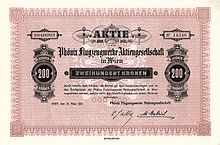Phoenix Aircraft Works
The Phoenix Aircraft were an Austro-Hungarian aircraft maintenance facility based in Vienna . At first they only built license productions from the Albatros or Brandenburg company.
Planes
Phoenix CI
Their first own aircraft was the Phoenix CI , which the company of the manufactured under license Hansa Brandenburg C.II was derived. The CI was a two-seat reconnaissance and multi-purpose biplane and offered its gunner an excellent field of fire. It had two places, 230 HP Hiero, span 11.00 m, length 7.60 m, height 2.95 m, empty weight 800 kg, 175 km / h, max. Climbing time to 1000 m 4 min 30 sec.
Phönix built 96 of this product, which were tested in Vienna Aspern and put into service from spring 1918. They remained in service until the end of the First World War.
After the war, Sweden built 30 such machines under license , which remained in service until the late 1920s.
Phoenix D types
A total of 158 aircraft of the Phönix D series were manufactured, the last of which was delivered on November 4, 1918. These single-seaters flew with both the Air Force and the Navy. Many of them have also been converted into photo scouts.
The single-seater Phönix DI was a further developed version of the double-decker Hansa-Brandenburg DI , kuk KD. In the summer of 1917 a prototype was developed at 8:15 pm. During the flight tests, however, it soon became apparent that the fighter was fast, but was too clumsy in the air and, for this reason, was difficult to maneuver. Other prototypes were 20.16 (DI) and 20.18 (D.II).
Due to the urgent need for single-seaters, the Phönix DI was built in three series, types 128, 228 and 328, the only difference was the production of the Hiero 200 HP engines and in a second block, type D.II, with some modifications, also in three series, type 122, 222 and 322, again with 200 hp Hiero.
Of the following type D.IIa 422 with a Hiero engine with an output of 230 hp, 48 copies were made.
It was only later that attempts were made to improve maneuverability (with ailerons on all wings), which led to the Type D.III, type 222.100, only three devices were delivered until November 1918, all of them to the naval pilots of the Austro-Hungarian Navy, when J. .31. Two machines of the successor J.32 were delivered to Albania, the one-off J.41 remained in the factory in Vienna-Stadlau at the end of the war, it was sold to Sweden in 1919 together with the license rights and by the designer Edmund Sparmann personally, together with the Phönix CI 121,105 flown over to Sweden. The Type D.III was built in Sweden and used with BMW IIIa engines until 1927. A copy with an original Hiero engine is now in the Swedish Air Force Museum.
